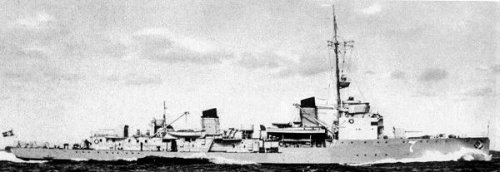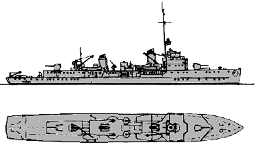
NAVYPEDIA
 Support the project with paypal
Support the project with paypal
Photo

F7 1940
Ships
| Name | No | Yard No | Builder | Laid down | Launched | Comp | Fate |
|---|---|---|---|---|---|---|---|
| F1 | 526 | Germaniawerft, Kiel | 8.1934 | 1.3.1935 | 12.1935 | depot ship Libelle 5.1941 | |
| F2 | 527 | Germaniawerft, Kiel | 8.1934 | 2.4.1935 | 2.1936 | torpedo recovery vessel 5.1940 | |
| F3 | 528 | Germaniawerft, Kiel | 8.1934 | 1.6.1935 | 3.1936 | depot ship Königin Luise 8.1938 | |
| F4 | 529 | Germaniawerft, Kiel | 8.1934 | 2.7.1935 | 4.1936 | surrendered 5.1945, to United Kingdom 1.1946, BU | |
| F5 | 530 | Germaniawerft, Kiel | 9.1934 | 14.8.1935 | 5.1936 | torpedo recovery vessel 4.1940 | |
| F6 | 531 | Germaniawerft, Kiel | 9.1934 | 1.10.1935 | 5.1936 | depot ship Hai 8.1938 | |
| F7 | 498 | Blohm & Voss, Hamburg | 1.1935 | 25.5.1935 | 2.1937 | torpedo recovery vessel 5.1940 | |
| F8 | 499 | Blohm & Voss, Hamburg | 1.1935 | 27.7.1935 | 4.1937 | torpedo recovery vessel 5.1940 | |
| F9 | 126 | MW Wilhelmshaven | 11.1934 | 11.5.1936 | 8.1937 | sunk 14.12.1939 | |
| F10 | 127 | MW Wilhelmshaven | 11.1934 | 11.5.1936 | 3.1938 | torpedo recovery vessel 5.1940 |
Technical data
| Displacement standard, t | 712 |
|---|---|
| Displacement full, t | 1028 |
| Length, m | 73.5 wl 76.0 oa |
| Breadth, m | 8.80 |
| Draught, m | 2.59 normal, 3.24 max |
| No of shafts | 2 |
| Machinery | F1 - 6: 2 sets Brown-Boveri geared steam turbines, 2 La Mont boilers F7: 2 sets Blohm & Voss geared steam turbines, 2 Velox-Benson boilers F8 - 10: 2 sets Blohm & Voss geared steam turbines, 2 La Mont boilers |
| Power, h. p. | 14000 |
| Max speed, kts | 28 |
| Fuel, t | oil 216 |
| Endurance, nm(kts) | 1500(20) |
| Armament | 2 x 1 - 105/42 SK C/32, 2 x 2 - 37/80 SK C/30, 4 x 1 - 20/65 C/30, 4 DCR (36), 50 - 62 mines |
| Electronic equipment | presumably GHG hydrophone |
| Complement | 121 |
Standard scale images

F7 1939
Graphics
Project history
F-type escorts (Flottenbegleiter: fleet escort ship) were intended, first of all, for escort of Deutschland-class pocket battleships. According to it the basic requirements to design consisted anti-submarine and minesweeping abilities and 28kts speed. As diesels with demanded power were not gone into assigned displacement, it has been decided to apply turbines on high parameters steam. F7 and F8 received high-pressure direct-flow boilers of Benson design (110atm, 480°C) and Blohm und Voss turbines, remaining ships had Lamont boilers (70atm, 450°C).
In service conditions these ships, or "F-boats", have shown full discordance to requirements shown to them. Because of the unsuccessful hull form they had seaworthiness not maintaining to any criticism, and uneconomical and unreliable power plants could not ensure sufficient endurance. For aft deck release under minesweeping equipment aft 105mm gun has been lifted on a superstructure that has aggravated serious problems with top weight, nevertheless usage of ships as minesweepers was appeared as impossible because of a deep draught and impracticality of machinery to slow speed.
Poor qualities of "F-boats" have induced fleet command even prior to the beginning of war to convert them to auxiliaries. F1 (23.5.1941), F3 (5.3.1940) and F6 (20.9.1939) were re-classified to command ships and renamed Libelle, Hai and Königin Luise respectively.
Modernizations
1939, F1 - 4, 6: were lengthened: length 77.8m wl, 80.3m oa, displacement was 768 / 1147t, fuel stowage rose to 240t, maximal speed decreased to 21kts.
Naval service
F9 was sunk 14.12.1939 by British submarine Ursula in Helgoland Bight. F5 was lost 29.1.1945 on a mine at Swinemünde. Königin Luise (ex-F1) was lost 30.3.1945 during raid of American bombers to Wilhelmshaven. Hai (ex-F3) was sunk 3.5.1945 by British aircraft in Kiel Bight. F2 has sunk for unknown reason at Scapa Flow 30.12.1946.
F4 was transferred to United Kingdom, BU in 1949. F7 was transferred to the USSR as Buran, BU in 1959. Jagd (ex-F1), F8 and F10 were transferred to the USA, and sold for scrap in France and Netherlands in 1947-1949.
 HOME
HOME FIGHTING SHIPS OF THE WORLD
FIGHTING SHIPS OF THE WORLD GERMANY
GERMANY ESCORTS
ESCORTS F1 escorts (1935 - 1938)
F1 escorts (1935 - 1938)
